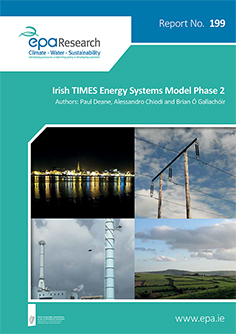Research 199: Irish TIMES Energy Systems Model Phase 2
Authors:Paul Deane, Alessandro Chiodi and Brian Ó Gallachóir
Summary: Research Report 199 on Irish TIMES Energy Systems Model Phase 2

Identifying Pressures
The Irish TIMES Phase II project identifies pressure points and challenges for Ireland in meeting greenhouse gas emission reduction targets while also addressing other policy goals such as energy efficiency and renewable energy targets. It makes an important contribution to Ireland’s technical capability to quantifying the challenges of moving to a low carbon economy. It also makes valuable contributions to the international collaborative research effort in TIMES energy systems modelling (used in over 70 countries to inform policy decisions) co-ordinated by the IEA ETSAP activity.
Informing Policy
Projected scenarios offer insights to key technologies and strategies to reduce emissions in the short and longterm out to 2050. Analysis addresses key policy questions ensuring the research directly supports policy makers. It is shown that a multi model approach to testing scenarios greatly improves the technical robustness of results from the model. Results highlight that cross border power flows play a more significant role in market dynamics especially in the presence of geographically dispersed variable renewable generation sources such as wind and solar. This is important from a policy making perspective as poor model based evidence for example, based on an isolated national system, can lead to poorly informed policy decisions.
Developing Solutions
Modelling results show that electrification of residential heating may rise by the year 2020 in order for Ireland to meet its non-ETS emission reduction target in a cost optimal fashion and that greater electrification of existing oil fired central heating systems through ASHP technology should warrant further investigation. Results also point to gas (both renewable and natural gas) becoming the dominant fuel source for Ireland to 2050. In this particular analysis it was shown that technical solutions in agriculture may contribute with some emissions reductions – however these reductions represent less than a 20% reduction relative to 1990 levels – while the bulk of cost optimal emissions reductions remain in the energy related sectors. Comparing with the findings of the EU roadmap the results indicated that in the case of Ireland an 80% to 95% GHG emissions reduction by 2050 would be very challenging without also reducing activity levels of the agriculture sector.
https://www.epa.ie/media/epa-2020/publications/research/EPA---Research-Report-199_20mm[1].jpg